
The Belgian Blue is a breed of beef cattle from Belgium. It may also be known as the Race de la Moyenne et Haute Belgique, or dikbil. Alternative names for this breed include Belgian Blue-White; Belgian White and Blue Pied; Belgian White Blue; Blue; and Blue Belgian. The Belgian Blue's extremely lean, hyper-sculpted, ultra-muscular physique is termed "double-muscling". The double-muscling phenotype is a heritable condition resulting in an increased number of muscle fibres (hyperplasia), instead of the (normal) enlargement of individual muscle fibres (hypertrophy).
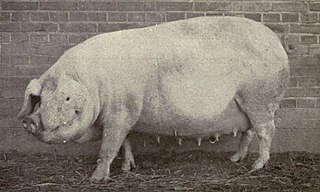
The Danish Landrace, Danish: Hvid Dansk Landrace, is a Danish breed of pig. It is of medium to large size, white in colour with a long body, fine hair, a long snout and heavy drooping ears. There are two distinct varieties, the white and the piebald

The American Landrace is an American breed of domestic pig. It is white in color, with a long body, fine hair, a long snout and heavy, drooping ears. Like all landrace pigs, it derives from the Danish Landrace.

The Berkshire is a British breed of pig. It originated in the English county of Berkshire, for which it is named. It is normally black, with some white on the snout, on the lower legs, and on the tip of the tail.
The Aksai Black Pied is a distinctively black and white spotted pig breed from Kazakhstan.
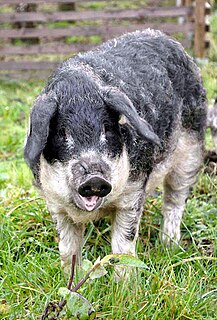
The Mangalica is a Hungarian breed of domestic pig. It was developed in the mid-19th century by crossbreeding Hungarian breeds from Nagyszalonta and Bakony with the European wild boar and the Serbian Šumadija breed. The Mangalica pig grows a thick, curly coat of hair. The only other pig breed noted for having a long coat is the extinct Lincolnshire Curly Coat pig of England.

The British Saddleback is a modern British breed of domestic pig. It was created in 1967 by merging the surviving populations of two traditional saddleback breeds, the Essex and Wessex Saddleback. It is an endangered breed, listed on the watchlist of the Rare Breeds Survival Trust as at risk, the second-highest level of concern.

The Dutch Landrace is a traditional Dutch breed of domestic goat. It has been known in the Netherlands since the seventeenth century, and was formerly numerous there. It came close to extinction in the 1950s, but was saved by cross-breeding with unrelated goats, and by 2020 numbered over 2000 head.
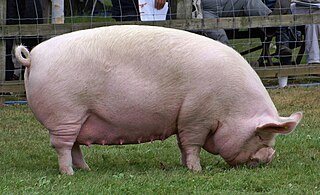
The Middle White is a British breed of domestic pig. It originated in Yorkshire, and derived from the Large White and the now-extinct Small White. It was recognised in 1852, and the first herd-book was published in 1884. It is a porker, reared for fresh pork, and is characterised by a short and sharply-upturned snout. After the Second World War it came close to extinction; although numbers have recovered somewhat, it is listed by the Rare Breeds Survival Trust as "priority" – the highest level of risk.

The Welsh is a breed of domestic pig native to Wales. It is a large white breed known for its hardiness in outdoor (extensive) farming, its long, pear-shaped body and its lop-ears. The breed was first mentioned in the 1870s, and after the Howitt committee report in 1955, became the third most common sire in the United Kingdom after the Large White pig and British Landrace pig. The Welsh pig experienced a decline in numbers in the late twentieth century because consumer demands had changed and the carcase was considered too fatty. In 2005 the breed was considered endangered and later came under the auspices of the Rare Breeds Survival Trust. Since then numbers have expanded somewhat, and by 2012, the registered breeding herd had increased to over 1000 animals.

The Italian Landrace is an Italian breed of domestic pig. It derives from the Danish Landrace breed developed in Denmark at the end of the nineteenth century. Stock was imported into Italy after the Second World War. The breed has been selected principally for suitability for the production of prosciutto crudo. It is, after the Large White Italiana, the second-most numerous pig breed in Italy. The breed standard is issued by the Ministero delle Politiche Agricole Alimentari e Forestali, the Italian ministry of agriculture and forestry; the herdbook is kept by the Associazione Nazionale Allevatori Suini, the national pig-breeders' association.
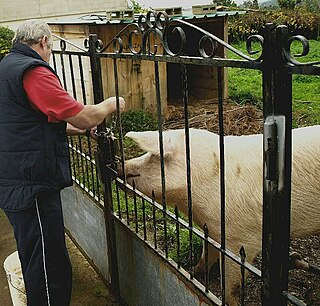
The Swedish Landrace is the leading breed of pig in Sweden. They have heavy drooping ears and a white coat. The Swedish strain of the Landrace pig originated from importations from neighboring countries, particularly Denmark. The Swedish Landrace have attracted attention in the United States and other nations in recent years.
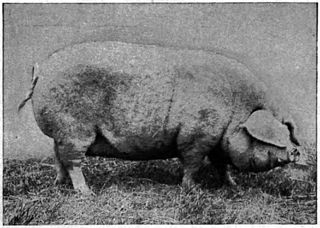
The Lincolnshire Curly Coat or Lincolnshire Curly-coated, also known as the Baston Pig, is an extinct British breed of domestic pig. It originated in, and was named for, the county of Lincolnshire, in the East Midlands. Like many other traditional pig breeds, it became rare after the Second World War. By 1970, it had disappeared. An older, still existing breed of similar looking pigs is the Hungarian Mangalica.
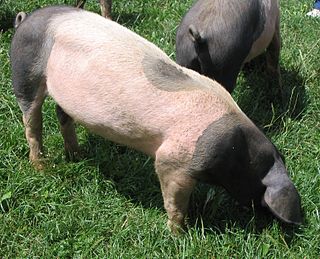
The Swabian-Hall swine is a breed of domestic pig originating from Schwäbisch Hall in Baden-Württemberg, Germany. It is a large pig, white in the centre with a black head and rear and narrow grey bands at the transition from white to black skin. They have large litters averaging more than nine piglets.

The British Landrace is a British domestic breed of pig and one of the most popular in the United Kingdom. It is white with heavy drooping ears that cover most of the face and is bred for pork and bacon. The breed originated in the 1949 importation of 12 landrace pigs from Scandinavia — four boars and eight gilts. In 1950, the British Landrace Pig Society was formed and it opened a herd book for the first offspring born from the imported 12. They created the first pig testing scheme with a testing station at the village of Stockton-on-the-Forest in North Yorkshire.
The Chato Murciano is a breed of domestic pig originating from Murcia, Spain. It is the only surviving breed of pig locally and historically produced in Murcia and is at the risk of extinction. Despite its danger of becoming extinct, the Chato Murciano is a well-managed pig known for its production of bacon and lean pork. Several Spanish authorities specialising in agriculture work on programs aiming to conserve the breed by cross-breeding and artificial insemination
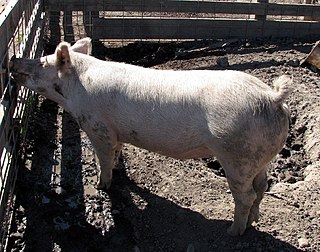
The Australian Yorkshire is a breed of domestic pig from Australia that was originally a part of the Yorkshire breed of pigs from Yorkshire, England. It is said to be the most common and popular breed of pig in Australia due to economic and nutritional advantages.
The Bulgarian White is a breed of domestic pig from Bulgaria. It was originally created through a grading up breeding process that involved breeding Large Whites and Edelschwein lines with native Bulgarian pigs in the early twentieth century.
The Dutch Landrace pig is a standardized breed of domestic pig originating in the Netherlands. The breed was developed from the native landrace of pigs of the area, crossbred with strains from neighboring counties. The Dutch Landrace is considered "a meaty and efficient breed". The breed is unusually responsive to the halothane test, which can be used to weed out individuals with low projected survivability and meat production.
The Large White Ulster, or Ulster White, was a breed of domestic pig. Primarily bred for bacon production, it was the favoured breed of farmers in the north of Ireland up until the mid 20th century.















